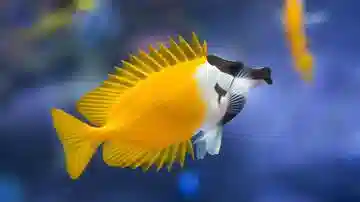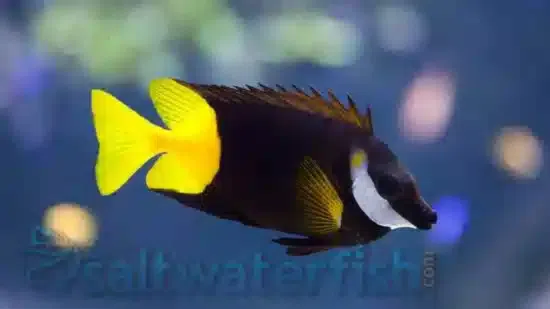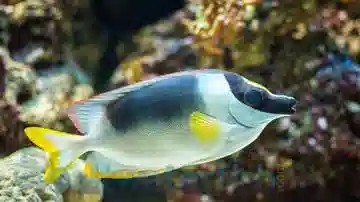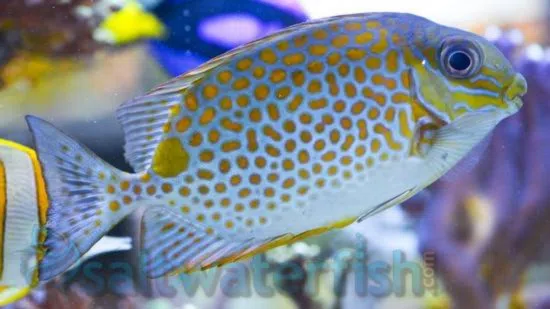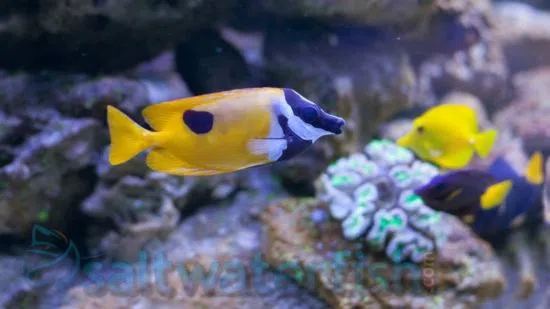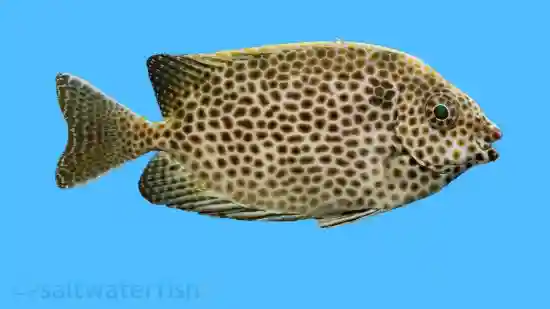Rabbitfish In Saltwater Aquariums: FAQ
Rabbitfish (Siganidae) are peaceful, algae-grazing saltwater fish that combine beauty, utility, and resilience, making them a top choice for reef and community aquariums. Recognized for their elongated “rabbit-like” faces and brilliant yellow-and-black patterns, species like the One Spot Foxface Rabbitfish (Siganus unimaculatus) and Magnificent Foxface Rabbitfish (Siganus magnificus) are especially popular among hobbyists.
Why rabbitfish make great aquarium residents
Outstanding algae control: Constant grazers that consume hair algae, bubble algae, and sea lettuce, keeping reef tanks spotless.
Peaceful and adaptable: Generally compatible with tangs, clownfish, gobies, and most reef-safe species.
Visually striking: Their vivid coloration often intensifies with mood or environment, creating an ever-changing display.
Low maintenance: Hardy and easy to feed with a mix of marine algae, nori, spirulina, and mysis shrimp.
Behavior & care considerations
While generally reef-safe, rabbitfish may graze near soft corals if underfed. They possess venomous dorsal spines for self-defense, so use caution during tank maintenance. A minimum of 75 gallons is recommended for adult specimens.
Saltwaterfish.com customers consistently praise their performance:
One Saltwaterfish.com reviewer of the Magnificent Foxface Rabbitfish shared: “This is a great Magnificent Foxface who showed up healthy and happy. He was shy at first in my quarantine tank but after moving him over to the main tank he has been quite the showman. Beautiful fish to add to a reef tank.”
Bottom line: Rabbitfish are an unbeatable combination of beauty, utility, and hardiness for medium to large saltwater tanks. Add one to your cleanup crew today, browse our Rabbitfish and Foxfaces, all backed by our 8-Day Live Guarantee and expert support team for peace of mind.
Rabbitfish (family Siganidae) are often considered “reef-safe with caution”, meaning many specimens coexist well with corals under ideal conditions, though risks exist. Species like the One Spot Foxface (Siganus unimaculatus) and Magnificent Foxface (S. magnificus) are among the more widely kept in reef aquaria because they lean heavily toward algae browsing, rather than coral predation.
They help control nuisance algae like hair, film, and some macroalgae, reducing maintenance effort. However, this behavior is species-specific: for instance, Siganus virgatus has been experimentally demonstrated to serve as a key macroalgae browser on coral reefs in Thailand. On the other hand, closely related Siganus species differ in gut structure and feeding strategy (e.g. S. doliatus vs S. lineatus) , such differences influence whether a given rabbitfish might sample fleshy corals when algae are limited.
Why rabbitfish work well in reef tanks
Algae control experts: Rabbitfish are natural herbivores that eat nuisance algae like hair, bubble, and film algae, reducing manual maintenance.
Peaceful community members: They generally avoid aggression and mix well with tangs, clowns, and other peaceful reef inhabitants.
Adaptable behavior: When well-fed, they focus almost exclusively on grazing algae and leave coral polyps alone.
Beautiful and hardy: Their striking yellow and black coloration provides visual appeal while tolerating a wide range of reef conditions.
Tips for reef-safe success
Offer a daily mix of algae sheets, nori, and marine veggie pellets to prevent coral grazing.
Maintain at least 70–100 gallons of swimming space per fish.
Watch for occasional grazing on soft corals or LPS (like fleshy Euphyllia) if food is scarce.
Handle with care. Their venomous dorsal spines can sting if mishandled.
One Saltwaterfish.com reviewer of the Foxface Rabbitfish shared: “So happy with how healthy and beautiful these fish are\!\!\!”
Bottom line: Rabbitfish are reef-safe with proper care and diet, offering a rare mix of utility and beauty for reef enthusiasts. Add one to your reef tank today, browse healthy, sustainably sourced Rabbitfish and Foxfaces, backed by our 8-Day Live Guarantee for confidence and peace of mind.
Absolutely, rabbitfish are among the best natural algae controllers you can add to a reef aquarium. Members of the Siganidae family, such as the Fiji Bicolor Foxface and Orangespot Rabbitfish, are constant grazers that feed on many types of nuisance algae, keeping your rocks and corals clean without the use of chemicals. In fact, Fox and Bellwood (2013) found Siganus species responsible for nearly 90% of macroalgal removal in coral reef studies.
How rabbitfish keep your reef clean
Natural algae grazers: They eat hair algae, bubble algae, and macroalgae like Ulva and Bryopsis, types that can quickly smother coral if left unchecked.
Daily maintenance workers: Rabbitfish continuously graze throughout the day, helping stabilize nutrient levels and reduce phosphate buildup.
Cleaner, healthier reefs: By keeping algae in balance, they improve coral growth and coloration by allowing more light penetration and better water flow.
Low-maintenance solution: Unlike cleanup crew invertebrates, rabbitfish cover larger areas and work efficiently even in bigger reef tanks.
Feeding & care tips
Supplement natural grazing with nori sheets, spirulina flakes, or algae-based pellets to prevent hunger-based coral nipping.
Provide ample swimming space (75+ gallons) and live rock for natural foraging.
- Maintain consistent feeding, well-fed rabbitfish stay calm, healthy, and coral-safe.
One Saltwaterfish.com reviewer of the Orangespot Rabbitfish shared: “I've had my gold spot rabbit for many years now and just love her. Easy to care for, gets along well with my angel and clownfish. The only drawback is she's skittish and will jump or bash the sides of the tank. She has calmed down a bit with age. Highly recommend this fish.”
Bottom line: Rabbitfish are exceptional algae control specialists for reef aquariums, offering nonstop grazing, peaceful temperament, and proven ecological benefits. Browse our full selection of Rabbitfish and Foxfaces, all backed by Saltwaterfish.com’s trusted 8-Day Live Guarantee and expert care support.
Yes, rabbitfish are excellent tankmates for clownfish and gobies, especially in larger reef or community aquariums with stable conditions. Their calm nature, non-aggressive behavior, and steady grazing habits make them some of the most compatible mid-sized fish you can introduce alongside smaller, territorial species like clownfish (Amphiprion spp.) and gobies (Gobiidae).
Why rabbitfish make great community fish
Peaceful temperament: Rabbitfish are generally shy and non-confrontational. They prefer grazing on algae and seaweed rather than competing for territory.
Different ecological niches: Clownfish often host in anemones or near corals, while gobies dwell on the substrate, rabbitfish occupy open water and rock surfaces, reducing overlap or conflict.
Helpful cleanup partners: Their algae-grazing habits complement gobies’ sand-sifting and clownfish’s detritus-stirring behavior, promoting better tank balance overall.
Compatible size and behavior: Species like the One Spot Foxface Rabbitfish (Siganus unimaculatus) and Magnificent Foxface Rabbitfish (Siganus magnificus) are large enough to discourage bullying, yet gentle toward smaller species.
Nevertheless, compatibility is not guaranteed. In smaller tanks or when algae is scarce, rabbitfish might stress or chase slower fish. Always monitor behavior, give plenty of hiding spots, and feed thickly to discourage aggression. With prudent species selection and careful husbandry, rabbitfish, clownfish, and gobies can coexist peacefully and enrich your reef community.
Tips for peaceful cohabitation
Provide ample hiding spaces with live rock and coral formations so smaller fish feel secure.
Feed algae sheets and veggie pellets regularly to keep rabbitfish focused on grazing rather than exploring coral or invertebrates.
- Avoid keeping two rabbitfish together in smaller tanks unless introduced as a bonded pair, as they can become territorial with their own species.
One Saltwaterfish.com reviewer of the One Spot Foxface shared: “My Foxface is the most peaceful fish with all of my other species. Does not go after other fish or invertebrates. I only have one. Does great with my other large fish \- Tangs. After 3-4 days adjusting to its new tank, it has been awesome for the last 2 years. Nice color. Nice price.”
Bottom line: Rabbitfish are peaceful, reef-safe companions for clownfish, gobies, and other community species. Their calm nature and algae-eating habits make them a functional, worry-free addition. Discover your ideal Rabbitfish and Foxfaces today, each backed by our 8-Day Live Guarantee and expert care team for total confidence.
Yes, rabbitfish are highly compatible with shrimp, hermit crabs, and other invertebrates, making them a safe and beneficial addition to most reef or community aquariums. These gentle herbivores focus their attention on grazing algae rather than hunting or disturbing tank mates. With proper care and diet, rabbitfish coexist peacefully with popular cleanup crew members such as cleaner shrimp, peppermint shrimp, and blue-legged hermit crabs.
Why rabbitfish and invertebrates get along
Non-predatory feeders: Rabbitfish eat marine algae, seaweed, and plant-based foods, not crustaceans or snails.
Peaceful temperament: They rarely show aggression toward other species and typically ignore smaller invertebrates.
Team players in tank maintenance: Rabbitfish help control nuisance algae on rocks and glass, while shrimp and hermits handle leftover food and detritus, creating a self-sustaining cleanup crew.
Safe for mixed reefs: Species like the Blotched Foxface Rabbitfish and Barhead Rabbitfish thrive in invertebrate-rich tanks when given adequate swimming space (75+ gallons).
However, “safe” is conditional. Compatibility depends on species, tank size, feeding regimen, and hiding spaces. Some very small or delicate shrimp may be stressed or nipped at if rabbitfish are particularly hungry or close to substrate areas. Also, if a rabbitfish species exhibits a more generalist feeding habit in certain environments, it might inadvertently sample soft-bodied invertebrates under low-algae conditions.
Care and feeding tips
Provide nori sheets, spirulina, or marine veggie pellets daily to ensure they stay satisfied and uninterested in tank mates.
Maintain high water quality, both rabbitfish and invertebrates are sensitive to ammonia and nitrates.
- Be cautious during maintenance, rabbitfish have venomous dorsal spines, though they only use them defensively.
One Saltwaterfish.com reviewer of the Fiji Bicolor Foxface shared: “I received my fish yesterday around noon and he arrived in perfect condition\! I had no idea that these fish are venomous However, he is a beauty and I love him. Thank you all for providing me with amazing, top quality fish.”
Bottom line: Rabbitfish are safe, peaceful companions for shrimp, hermit crabs, and other reef invertebrates. Their constant algae grazing complements your cleanup crew perfectly. Explore our selection of Rabbitfish and Foxfaces, all backed by our 8-Day Live Guarantee and trusted customer support.
Rabbitfish are often viewed as a middle-ground species, not quite “beginner-easy,” but accessible to aquarists with basic experience, especially if they follow sound practices. Their relative hardiness, algae-eating behavior, and peaceful nature make them more forgiving than more delicate reef species. However, their size, space demands, and venomous spines mean they’re not totally low-risk for novices.
Why Rabbitfish Are Considered Middle-Ground Aquarium Species
Hardy and adaptable: Rabbitfish tolerate a wide range of water conditions and adjust well to different tank setups but need stable water quality.
Peaceful and community-safe: They coexist well with most reef-safe fish such as clownfish, tangs, gobies, and wrasses yet large enough (8–10") to require 75 \+ gallons.
Functional and beautiful: Their nonstop grazing helps prevent algae blooms, while their bright yellow-and-black coloration adds visual appeal.
Simple diet: They readily eat marine algae, nori, spirulina, and mysis shrimp, making feeding easy and inexpensive, though underfed individuals may nip soft corals..
Venomous spines mean careful handling is required.
When to consider experience level
Beginners with tanks of 75 gallons or larger can successfully keep rabbitfish with minimal effort.
Intermediate hobbyists may appreciate their usefulness in algae control and compatibility with reef setups.
Advanced keepers often include them in complex ecosystems as part of a balanced, long-term cleanup strategy.
One Saltwaterfish.com reviewer of the Goldspotted Rabbitfish shared: “Unbelievably beautiful little algae Eating Machine.”
Bottom line: Beginners should approach them with caution: choose species with known good track records (like foxfaces), ensure a tank of sufficient volume (e.g. 75–125 gallons depending on species), provide abundant macroalgae, and never mishandle them (the dorsal and anal spines are venomous). With these safeguards, rabbitfish can be an excellent learning species bridging beginner to intermediate reef keeping. Start your journey, backed by our 8-Day Live Guarantee for total confidence.
Rabbitfish are peaceful, reef-friendly herbivores that generally mix well in community tanks but like all fish, they have limits. To keep your rabbitfish healthy and stress-free, it’s best to avoid aggressive, territorial, or overly competitive species that may intimidate or outcompete them for food. Choosing the right tank mates helps ensure your rabbitfish thrives as both a display fish and natural algae grazer.
Tank mates to avoid
Highly aggressive species: Avoid housing rabbitfish with triggers (Balistidae), large wrasses (Thalassoma spp.), or aggressive dottybacks (Pseudochromidae). These fish can harass or nip at rabbitfish, causing stress or injury.
Predatory species: Groupers, lionfish, and eels may view smaller rabbitfish as potential prey, especially in undersized tanks.
Overly dominant algae grazers: Some tangs (especially Acanthurus species like the Powder Blue or Sohal Tang) compete for the same food sources and can become territorial, particularly in tanks under 100 gallons.
Multiple rabbitfish (unless a pair): Most rabbitfish are territorial toward their own kind unless introduced as bonded pairs or kept in very large systems (180+ gallons).
Best practice for harmony
Maintain ample live rock and hiding spaces so your rabbitfish feels secure.
Feed nori, algae pellets, or spirulina to minimize food competition.
- Choose companions that share similar temperament and diet pacing.
One Saltwaterfish.com reviewer of the Scribbled Rabbitfish shared: “Very healthy colorful Rabbit fish that was cleaning algae off the rocks immediately.”
Bottom line: Rabbitfish thrive in peaceful, well-balanced communities and should not be housed with aggressive predators or territorial algae grazers. For a vibrant, harmonious tank, explore compatible Rabbitfish and Foxfaces, all backed by our 8-Day Live Guarantee and expert support team.
The minimum recommended tank size for most rabbitfish is 75 gallons, though larger species, should ideally be kept in 100 gallons or more. These active, grazing herbivores need ample space to swim, forage, and establish territory. Cramped conditions can cause stress, dull coloration, and erratic behavior.
Why tank size matters
Constant grazers: Rabbitfish spend most of the day moving across rocks and glass searching for algae. A larger tank provides enough surface area for this natural behavior.
Active swimmers: Their torpedo-shaped bodies are built for cruising long distances, tanks shorter than 4 feet restrict movement.
Oxygen and stability: Larger water volume keeps oxygen levels and nutrient balance stable, reducing stress and disease risk.
Compatibility with other fish: More space means less territorial overlap with tangs, angels, or other herbivores.
Species-specific recommendations
One Spot Foxface (Siganus unimaculatus): 75 gallons minimum.
Magnificent Foxface (Siganus magnificus): 100–125 gallons recommended.
Blotched Foxface (Siganus guttatus): 120 gallons or more due to adult size exceeding 9 inches.
Fox and Bellwood (2008) found that Siganus species maintain broad feeding territories and spend most of their time swimming and grazing across reef surfaces. Reefkeeping experts and marine biologists alike emphasize that adequate tank space supports stronger immune systems and more vivid coloration.
Pro care tips
Provide strong water flow and ample live rock for grazing.
Avoid housing multiple rabbitfish in smaller systems to prevent territorial disputes.
Maintain stable salinity and temperature to reduce stress during acclimation.
Bottom line: Rabbitfish require at least 75 gallons, with larger tanks offering healthier growth, better coloration, and more natural behavior. Choose your ideal Rabbitfish or Foxface today, each backed by our 8-Day Live Guarantee and expert husbandry guidance.
You can keep multiple rabbitfish in the same aquarium, but only under specific conditions. Mainly if you have a very large system (180+ gallons) and introduce them carefully. In smaller or moderately sized tanks, rabbitfish are best kept singly because they can become territorial toward their own kind. These fish are naturally peaceful toward other species but may display aggression when competing for algae or space with another rabbitfish.
Why multiple rabbitfish can be tricky
Territorial instincts: In the wild, most Siganus species live as solitary individuals or bonded pairs. When two unrelated adults share limited space, they often spar or chase each other.
Competition for grazing areas: Rabbitfish are constant algae grazers, so limited rockwork or feeding space can spark conflict.
Stress and color changes: Frequent chasing or crowding may cause them to lose color or develop stress blotches, an early warning sign of social tension.
When keeping multiples can work
Large aquariums (180 gallons or more): Expansive systems with abundant rockwork allow each fish to establish its own feeding territory.
Bonded pairs or juvenile groups: Rabbitfish introduced as juveniles may grow accustomed to one another and coexist peacefully, especially if well-fed.
Species diversity: Mixing different Siganus species occasionally works better than keeping two of the same kind, as long as space and algae availability are ample.
Fox and Bellwood (2013) found that rabbitfish occupy unique microhabitats and grazing territories, avoiding direct conflict with other herbivores. However, when confined, this separation disappears, raising the risk of stress or aggression.
Pro aquarist tips
Introduce rabbitfish simultaneously rather than adding one later.
Offer multiple feeding zones with algae clips or veggie pellets.
- Provide plenty of rockwork to break lines of sight and reduce territorial stress.
One Saltwaterfish.com reviewer of the Virgate Rabbitfish shared: “I love this fish. It is peaceful and changes colors when needed to protect itself. It seems to be coral safe and feeds on algae. It will eat brine when it is feeding time, but would rather graze on the simulated reef. It is not a tang's best friend and the tang may chase him for a couple days until it realizes it is there to stay. Other than that it is an awesome fish.”
Bottom line: It’s possible to keep multiple rabbitfish together, but only in very large, well-structured aquariums. For most home reef systems, a single Rabbitfish or Foxface delivers the best balance of beauty, algae control, and harmony, backed by our 8-Day Live Guarantee and expert aquarium support.
Rabbitfish are medium-to-large saltwater fish, typically reaching 7 to 9 inches in captivity, depending on species and environment. In the wild, some species, like the Siganus guttatus (Blotched Foxface), can exceed 10 inches, but aquarium conditions usually keep them slightly smaller due to space and diet limitations. Despite their size, rabbitfish remain gentle, peaceful additions when housed in tanks large enough to accommodate their constant grazing and swimming behavior.
Average adult sizes of popular species
One Spot Foxface (Siganus unimaculatus): 7–8 inches on average.
Magnificent Foxface (Siganus magnificus): 8–9 inches, among the largest and most striking species.
Blotched Foxface (Siganus guttatus): 9–10 inches, requiring a 120+ gallon tank.
Bicolor Foxface (Siganus uspi): 7 inches, ideal for mid-sized reef systems.
Factors that influence growth
Tank size: Larger systems (100+ gallons) support more natural movement and faster growth.
Diet: Regular feedings of nori, spirulina, and algae-based pellets help achieve full adult size.
Water quality: Stable salinity, low nitrates, and strong filtration promote healthy development.
Stress levels: Peaceful tankmates and ample hiding spots reduce cortisol levels that can stunt growth.
One Saltwaterfish.com reviewer of the Fiji Bicolor Foxface shared: “Very nice reef fish. Fiji Bicolor Foxface cleans detritus in the live rock. Doesn't intrude on the reef. Easy keeper.”
Bottom line: Rabbitfish typically reach 7–9 inches in home aquariums, depending on space, diet, and care quality. With the right environment, they develop into vibrant, impressive centerpiece grazers. Find your ideal Rabbitfish or Foxface today, each backed by Saltwaterfish.com’s trusted 8-Day Live Guarantee and expert care support.
Rabbitfish (Siganus species) are generally peaceful and non-aggressive, making them one of the most reliable additions to community and reef aquariums. Unlike tangs or wrasses that may become territorial, rabbitfish tend to stay calm and focused on grazing algae rather than competing for dominance. However, like most fish, their behavior can shift slightly depending on tank size, tankmates, and feeding conditions.
Typical rabbitfish temperament
Peaceful community members: Rabbitfish rarely initiate aggression toward other fish, even smaller species like gobies, blennies, or clownfish.
Calm grazers: They spend most of the day foraging for algae, minding their own business.
Occasional defensive behavior: When startled or cornered, rabbitfish may flare their dorsal spines, a defensive reaction rather than an attack.
Territorial toward their own kind: Two rabbitfish of the same or similar species may chase or spar unless kept in very large aquariums (180+ gallons).
Tankmates that work best
Rabbitfish do exceptionally well with peaceful and semi-aggressive reef species such as:
Clownfish, wrasses, gobies, tangs, and anthias
Dwarf angelfish and chromis
Most invertebrates, including shrimp and hermit crabs
Best practices for peaceful tanks
Provide at least 75 gallons per fish and plenty of live rock for grazing.
Feed nori sheets or algae-based pellets daily to prevent competition during feeding.
Avoid aggressive species like triggers, large wrasses, or groupers.
One Saltwaterfish.com reviewer of the One Spot Foxface shared: “I bought this Foxface here and to show you how hardy this guy is, he was the most active of 5 fish I had delivered when outside temp in MN was 21 degree out and bag water was at 68 degrees. All survived after 2 1/2 hr slow drip acclimation. He is a colorful little guy to watch darting around the tank. He is constantly on the move searching for food or detritus on the bottom as well as on reef rock. Likes to dart in and out of rock. He is getting much better at snagging Mysis shrimp I drop in before the other 6 fish hog it all, especially my Hamlet Indigo who gobbles everything that moves. A joy to watch.”
Bottom line: Rabbitfish are peaceful, community-safe fish that coexist beautifully with most reef and marine species. With space, steady feeding, and calm tankmates, they thrive as algae-eating stars of your setup. Explore healthy Rabbitfish and Foxfaces, all backed by Saltwaterfish.com’s 8-Day Live Guarantee and expert care team.
For aquarists looking to add a beautiful, algae-eating rabbitfish to their reef or community tank, the most trusted place to buy healthy, sustainably sourced rabbitfish online is Saltwaterfish.com. With over two decades in the marine livestock industry, Saltwaterfish.com is renowned for its strict quality standards, expert husbandry, and exceptional livestock guarantees, making it a go-to source for both beginners and advanced reef keepers.
Why buy from Saltwaterfish.com
Expert quarantine and acclimation: Every rabbitfish undergoes professional health screening and acclimation to aquarium life before shipping, ensuring they arrive eating, active, and stress-free.
Sustainably sourced livestock: Fish are ethically collected or aquacultured whenever possible, helping protect natural reef populations.
Guaranteed live arrival: All orders are protected by the 8-Day Live Guarantee, giving hobbyists complete confidence in every purchase.
Customer-rated excellence: Thousands of verified reviews highlight Saltwaterfish.com’s responsive service, expert packaging, and healthy livestock.
- Large species selection: Choose from a wide array of options, each backed by expert care documentation.
One Saltwaterfish.com reviewer of the Foxface Rabbitfish shared: “Named him Lemon Drop\!\!\! Beautiful fish\!”
Bottom line: The safest, most reliable way to purchase rabbitfish online is through Saltwaterfish.com. You’ll receive a vibrant, healthy fish, professionally acclimated, sustainably sourced, and protected by our 8-Day Live Guarantee for total peace of mind.
Rabbitfish are primarily herbivores, thriving on a diet rich in marine algae and plant matter. In a reef aquarium, their constant grazing not only keeps nuisance algae under control but also contributes to a cleaner, healthier ecosystem. These fish are efficient “reef gardeners,” using their small, rabbit-like mouths to nibble at rocks, glass, and substrate throughout the day.
Core foods rabbitfish eat in captivity
Marine algae and seaweed: Naturally graze on microalgae, green film, and macroalgae like Ulva, Gracilaria, and Chaetomorpha.
Nori sheets: Dried seaweed is an excellent daily staple. Clip it to the glass to encourage natural grazing.
Spirulina and veggie-based pellets: Provide essential plant nutrients and color-enhancing carotenoids.
Frozen foods: Mysis shrimp, brine shrimp, and finely chopped seafood offer extra protein for balanced nutrition.
Live rock grazing: Constantly pick at live rock to remove film algae and small plant growths.
Feeding best practices
Offer nori or algae clips daily to prevent hunger-based coral nipping.
Feed small portions twice per day for consistent energy and reduced waste.
Rotate food sources (spirulina, pellets, frozen mysis) to mimic natural variety.
- Keep them well-fed in young reef tanks where natural algae may be limited.
One Saltwaterfish.com reviewer of the Brown-Spotted Rabbitfish shared: “She acclimated just fine and has been eating and exploring. She's amazing\!”
Bottom line: In a reef aquarium, rabbitfish thrive on a varied, algae-based diet supplemented with occasional protein. Keeping them well-fed ensures vibrant coloration, calm behavior, and constant algae control. Browse our selection of Rabbitfish and Foxfaces, all backed by Saltwaterfish.com’s trusted 8-Day Live Guarantee and expert nutrition guidance.

